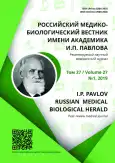Etiological structure and antibacterial therapy of purulent meningitis in neurological patients
- Authors: Kubrakov K.M.1, Semenov V.M.1, Marshalko O.V.2, Migunova V.A.3
-
Affiliations:
- Educational Establishment Vitebsk State Order of Peoples' Friendship Medical University
- Ministry of Health Сare
- Mogilev Regional Children’s Hospital
- Issue: Vol 27, No 1 (2019)
- Pages: 20-29
- Section: Original study
- URL: https://journals.rcsi.science/pavlovj/article/view/11485
- DOI: https://doi.org/10.23888/PAVLOVJ201927120-29
- ID: 11485
Cite item
Abstract
Purulent meningitis is one of the most severe forms of inflammatory brain lesions. Mortality rate in purulent meningitis amounts 10.0-25.0%.
Aim. To study the etiological structure and resistance to antibacterial drugs, to optimize the algorithm of etiotropic therapy of purulent meningitis in neurological patients.
Materials and Methods. The data on etiology and resistance of causative agents of purulent meningitis in 54 neurological patients (28 of them are male; the average age is 47 (33.5; 58) years) for the period of 2010-2018 are presented in the article. The cerebrospinal fluid (CSF) study included general, biochemical, bacteriological analyses as well as the study of the D-lactate level. Identification of microorganisms and determination of resistance to antibacterial therapy was performed using identification test systems (ID) and strips (ATB) using the automatic microbiological analyzer ATB Expression (Bio Merieux, France). The combined test BD Directigen Meningitis Combo Test (Becton Dickinson, USA) was also used for the direct quantitative determination of antigens against H. influenzae, S. pneumoniae, N. meningitidis, E. coli. Statistical processing of the results was performed using Statistica 10.0 (Stat Soft Inc., USA) with the calculation of the sign frequency, 95.0% confidence interval (95.0% CI), median, upper and lower quartiles (Me [LQ; UQ]).
Results. 83.33% of meningitis cases in neurological patients have been established to be manifested by purulent inflammatory processes, which is confirmed by the results of the CSF analysis and the level of D-lactate (p<0.05) in it. The inoculability of pathogens from CSF was 61.90% (95.0% CI 46.59-77.22%). At the same time, microorganisms were isolated in the monoculture. Gram-positive microflora constituted 88.46% (95.0% CI 75.30-100.0%) among the isolated pathogens. The main pathogens of purulent meningitis in the studied patients’ sample were Str. pneumoniae (34.62%) and S. aureus (26.92%); 96.15% of the isolated strains are sensitive to the most commonly used antibacterial drugs to treat meningitis.
Conclusions. The etiological structure of purulent meningitis in neurological patients has been established. The resistance of pathogens to antibacterial drugs has been studied. The algorithm of etiotropic antibacterial therapy has been optimized.
Full Text
##article.viewOnOriginalSite##About the authors
Konstantin M. Kubrakov
Educational Establishment Vitebsk State Order of Peoples' Friendship Medical University
Author for correspondence.
Email: k-kubrakov@yandex.ru
ORCID iD: 0000-0001-6723-0589
SPIN-code: 9391-6027
ResearcherId: X-9783-2018
MD, PhD, Associate Professor, Associate Professor of the Department of Neurology and Neurosurgery
Belarus, 210023, Vitebsk, Frunze Av., 27Valery M. Semenov
Educational Establishment Vitebsk State Order of Peoples' Friendship Medical University
Email: k-kubrakov@yandex.ru
ORCID iD: 0000-0002-7029-9226
SPIN-code: 9021-5764
ResearcherId: Q-7777-2018
MD, PhD, Professor, Honored Worker of Science of the Republic of Belarus, Head of the Department of Infectious Diseases
Belarus, 210023, Vitebsk, Frunze Av., 27Olga V. Marshalko
Ministry of Health Сare
Email: k-kubrakov@yandex.ru
ORCID iD: 0000-0001-7822-6286
SPIN-code: 9391-6027
ResearcherId: B-6839-2019
MD, Associate Professor, Head of the Personnel Policy Department of Educational Institutions
Belarus, 220048, Minsk, Myasnikova Street, 39Victoria A. Migunova
Mogilev Regional Children’s Hospital
Email: k-kubrakov@yandex.ru
ORCID iD: 0000-0002-4736-0324
SPIN-code: 1078-9340
ResearcherId: X-9280-2018
Doctor
Belarus, MogilevReferences
- Costerus JM, Brouwer MC, Bijlsma MW, et al. Community-acquired bacterial meningitis. Current Opinion in Infectious Diseases. 2017;30(1):135-41. doi: 10.1097/QCO.0000000000000335
- Koroleva IS, Beloshiczkij GV.; Pokrovskij VI, editor. Meningokokkovaya Infekciya i Gnojny`e Bakterial`ny`e Meningity. Moscow: MIA; 2007. (In Russ).
- Mikhailova EV, Shteinberg AV, Eremeyeva IG. Algorithm of ethiologic diagnostics of meningitis in children taking into account protein level of acute inflammation stage. Detskie Infekcii. 2008; 7(3):61-4. (In Russ).
- Lucas MJ, Brouwer MC, van de Beek D. Neurological sequelae of bacterial meningitis. Journal of Infection. 2016;73(1):18-27. doi: 10.1016/j.jinf.2016.04.009
- Koroleva IS, Beloshitsky GV, Spirikhina LV, et al. Basic lines and results of researches on meningococcal infection and purulent bacterial meningitis. Epidemiology and Infectious Diseases. 2009;(2): 40-4. (In Russ).
- Mirecka A. Etiological agents of bacterial meningitis in adults and antibiotic susceptibility of Streptococcus pneumoniae isolated between 2009-2016 from patients of Regional Specialist Hospital of Dr Wł. Biegański in Lódź. Przegla̧d Epidemiologiczny. 2018;72(3):313-24. doi: 10.32394/pe.72.3.8.
- Solovey NV, Karpov IA, Davydov AV, et al. Diagnosis treatment and prophylaxis of community-acquired bacterial meningitis: the review of the guidelines of European Society for Clinical Microbiology and Infectious Diseases. Clinical Micro-biology and Antimicrobial Chemotherapy. 2017; 19(2):102-15. (In Russ).
- TSinzerling VA, CHukhlovina ML. Infektsionnyye Porazheniya Nervnoy Sistemy. Voprosy Etiologii, Patogeneza i Diagnostiki: Rukovodstvo dlya Vrachey. Saint-Petersburg: ELBI-SPb; 2011. (In Russ).
- Vengerov YuYa., Nagibina MV. Bakterial’nyy gnoynyy meningit. Spravochnik fel`dshera i akusherki. 2014;10:10-7. (In Russ).
- Koroleva IS, Beloshitsky GV, Chistyakova GG, et al. Epidemiological surveillance of purulent bacterial meningitis. Epidemiology and Infectious Diseases. 2004;3:21-5. (In Russ).
- Chen Z, Wang Y, Zeng A, et al. The clinical diagnostic significance of cerebrospinal fluid D‐lactate for bacterial meningitis. Clinica Chimica Acta. 2012; 413(19-20):1512-5. doi: 10.1016/j.cca.2012.06.018
- Leclercq R, Cantón R, Brown DF, et al. EUCAST expert rules in antimicrobial susceptibility testing. Clinical Microbiology and Infection. 2013;19(2): 141-60. doi: 10.1111/j.1469-0691.2011.03703.x
- Ouattara M, Whaley MJ, Jenkins LT, et al. Triplex real-time PCR assay for the detection of Streptococcus pneumoniae, Neisseria meningitidis and Haemophilus influenzae directly from clinical specimens without extraction of DNA. Diagnostic
- Microbiology and Infectious Disease. 2018;18(3): 482-6. doi: 10.1016/j.diagmicrobio.2018.10.008
- Heckenberg SG, Brouwer MC, van de Beek D. Bacterial meningitis. Handbook of Clinical Neurology. 2014;121:1361-75. doi: 10.1016/B978-0-7020-4088-7.00093-6
- Van Demark M. Acute bacterial meningitis: current review and treatment update. Critical Care Nursing Clinics of North America. 2013;25(3):351-61. doi:10. 1016/j.ccell.2013.04.004
- Vengerov YuYa, Nagibina MV. Likvorologicheskiye issledovaniya pri bakterial’nykh gnoynykh meningitakh. Zhurnal Infektologii. Prilozheniye. Materialy IV Kongressa Evro-Aziatskogo Obshchestva po Infektsionnym Boleznyam. 2016;8(2):29-30. (In Russ).
Supplementary files








